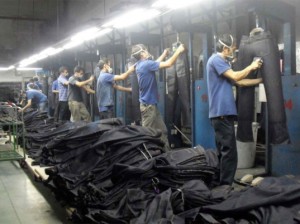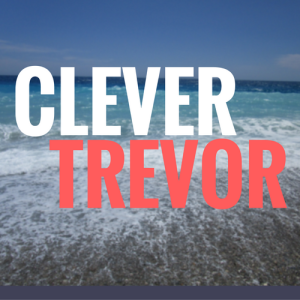The popular worn-out look in jeans is part of a 100 billion dollar global jeans industry that hides from public scrutiny and takes advantage of our ignorance. I recently watched a documentary about an ongoing issue in the denim production industry shown on Al Jazeera. The film was released in March 2015 and focuses on the continuing use of sand blasting in the production of jeans.
In the 101 East film Denim Blues, Al Jazeera uncovered evidence of poorly ventilated, dusty and dirty factories at Xintang in China’s Guangdong province, where an estimated 260 million pairs of jeans are produced each year
Sand blasting is an abrasive blasting technology that propels fine sand particles using compressed air. Its use in the denim industry is mainly to contribute to the fading look in jeans. Sand blasting compromises worker safety when it is used without proper protection. The technique should be performed in a well ventilated room with an individually contained air supply system, so that the workers are not inhaling air with sand particles. The lack of such safety measures leads to cases of silicosis – essentially scarring in lungs due to dust inhalation.

For more information, the Fair Trade Center in Sweden has done some in-depth research into the practice of sandblasting. They produced two papers on possible solutions to the sand blasting issue: Fashion Victims (2010) and Still Fashion Victims (2012). The most important point to take away would be that the current bans are not effective in abolishing sand blasting from the industry.
Sand blasting was a common technique in all jeans manufacturing before 2010, when top jeans brands abolished the use of the technique in their production. Levis, H&M, American Eagle, and Hollister are some of the brands that banned the use of sand blasting. Al Jazeera’s undercover film again brings public awareness back to the issue of sand blasting. I find it extremely worrisome that some of these brands are still working with manufacturers in China and Bangeldesh (there is a ban in Turkey) knowingly that they cannot possibly regulate the use of sand blasting.
I find it extremely unethical and morally flawed that the public needs to get outraged before there are steps towards change. Most of the news articles surfaced around 2010-2011 when the companies began to officially ban sand blasting. Once this concern faded from public view, there has been little pressure to maintain the level of regulation needed to ensure that sand blasting is expelled from the denim industry.
One of the alternatives to sand blasting is using potassium permanganate, which also has numerous health hazards. There are many other alternatives to sand blasting and there are advocates out there that recognize the issue, such as Redress, a Hong Kong operation that promotes environmental sustainability in the fashion industry. However, change is slow because companies are unwilling to invest into a cause that has largely died down a few years ago.
I have looked into multiple brand statements regarding sand blasting including Levis, H&M, American Eagle, Hollister, Abercrombie and Fitch, Primark, Target, and Armani. On each of their company pages, they mention the dangers and state that they use alternatives, but I keep questioning what alternatives these companies use.
Teams are working with vendors and other partners to discover alternative methods of distressing the denim, sans the harmful technique. For example, textile workers can distress denim by hand using safer tools
I would feel much more confident in brands that would prove that they are using different techniques. Calvin Klein and Dolce and Gabbana are not on board with the ban and I don’t see the negative effects on their companies. Again, this is one of those issues that people get hyped about, then kind of ignore.
Jeans have been in fashion for a long time and I love the comfort and flexibility in wearing jeans, but this definitely affects my view on the industry.

There is definately a great deal to find out about this topic.
I like all of the points you made.
LikeLike
Thank you for reading!!
LikeLike
I’ll immediately clutch your rss as I can not find your email subscription link or
newsletter service. Do you have any? Please permit me
understand in order that I could subscribe. Thanks.
LikeLike
That would be my mistake there! I just recently changed the layouts. The subscription should be at the bottom of my page now. Thank you for your interest! 🙂
LikeLike
I’ll right away seize your rss feed as I can not to find your e-mail subscription link or newsletter service.
Do you’ve any? Kindly allow me recognize so that I may subscribe.
Thanks.
LikeLike
Thank you for reading. You can subscribe to my blog at the bottom or my feed here https://clevertrev.wordpress.com/feed/
LikeLike
Nice response in return of this question with solid arguments
and telling the whole thing concerning that. https://xpgduane536642141.wordpress.com/2016/12/29/playing-about-the-web-truck-games/
LikeLike